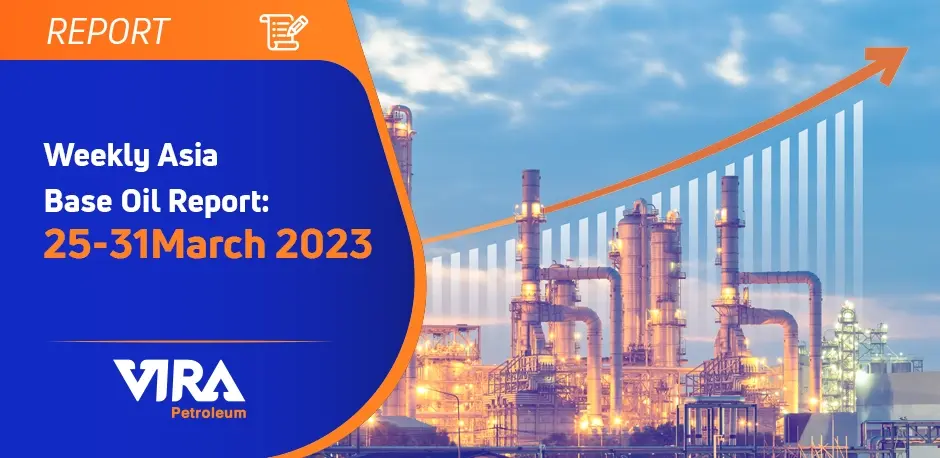Although the spring season began with low energy, prices for Asian base oil remained largely steady thanks to a balanced supply and demand ratio. In some countries, such as India, there are indications of healthier buying interest. However, volatile prices for crude oil and feedstocks have created uncertainty, causing some buyers to wait for a clearer picture of where base oil prices are headed before making a decision.
Base Oil Trends In China
An important market that suppliers continued to focus on was China, as it accounts for a significant portion of the world’s base oil demand, around 22 percent according to an analyst’s presentation at the ICIS Asia Base oils and Lubricants conference held in Singapore. As a result, trends in this market can have a significant impact on the overall performance of the region. However, during the COVID pandemic, strict lockdowns and rising infection rates led to reduced demand for lubricants and base oils, resulting in oversupply conditions and falling prices in Asia.
According to several economic reports, China’s trajectory appears to have stabilized, and it is expected to achieve a 5% GDP growth rate in 2023, compared to about 3% in 2022. The automotive and industrial sectors are predicted to experience healthy growth, which could lead to increased demand for base oils, lubricants, and fuels. In addition to domestic base oils, imports will be required to meet the growing demand, as China has a structural shortage of heavy-viscosity grades like the API Group I bright stock. However, some base oil plants in China are said to be operating at reduced rates to avoid product overhang, and a few units have been closed for maintenance.
The importation of large quantities of heavy viscosity base oils by China can have an impact on the regional supply system. This is because Chinese importers often have to compete with consumers in Southeast Asia for the same barrels of base oils, which can lead to a depletion of the available supply. In recent months, there has been a significant increase in the importation of Group II base oils from Taiwan into China. The sole Taiwanese Group II producer had previously been shipping its product to Southeast Asia, India and even the Americas. However, a large portion of its monthly output has now started to move back to China, which was a regular occurrence before the pandemic.
The increased importation of heavy viscosity base oils into China can result in a shift in the regional supply and demand balance. This may have implications for other countries in the region that also rely on these base oils for their manufacturing and industrial activities. Additionally, the competition for these base oils may drive up prices, which could impact the profitability of businesses in the region. It will be interesting to see how this trend evolves in the coming months and whether other producers in the region will increase their production to meet the growing demand for heavy viscosity base oils in China.
Reports indicate that the number of South Korean cargoes discussed for shipment to China in the coming weeks has reduced. This could be attributed to the conclusion of several cargoes to other destinations, leading to less material being available. Moreover, a South Korean Group II and Group III producer plans to shut down its base oils unit for about 45 days in mid-May, further limiting supply. Despite this, some South Korean cargoes were still being considered for shipment to China, such as a 4,000-metric ton parcel from Onsan to Nantong and Jingjiang in early April, as well as a 2,200-ton parcel from Onsan to Huizhou in mid-April. This indicates that there is still demand for South Korean base oils in China, albeit at a reduced volume.
Base Oil Trends In South Korea
In addition to the cargoes destined for China, there were also South Korean base oil shipments being discussed for other destinations. For instance, there was talk of a 1,000-ton parcel for lifting in Pyongtaek to Guayaquil, Ecuador, with flexibility for any dates in April. Furthermore, there was a 1,200-ton cargo scheduled to be shipped from Onsan to Singapore in early April. Another cargo of 4,800 tons was being considered for possible shipment from Ulsan to Havre, France. These discussions suggest that South Korean base oil suppliers are exploring various markets and destinations, and are actively seeking opportunities to expand their customer base.
Base Oil Trends In India
Suppliers seem to have found a glimmer of hope in India this week, as demand for light grades of base oil has started to increase. The rise in industrial activity and demand from the automotive segment has resulted in an uptick in the requirement for base oils, as per sources. However, there remains a competition between the imports and the domestic base stocks, which the Indian refiners can offer at reasonable prices, as they are produced from heavily discounted Russian crude oil.
India is witnessing an increase in base oil demand due to improved industrial activity and demand from the automotive segment, according to sources. Domestic base stocks in India are being produced from heavily discounted Russian crude oil and are being offered at attractive prices, leading to competition with imports. Despite the arrival of several import cargoes from the US, Europe, and the Middle East, discussions to finalize additional shipments in April were ongoing. Prices were stable in India, but heavy-vis grades and bright stock faced downward pressure.
Several shipments were being discussed, including a 17,000-ton cargo from Cartagena, Spain, to Mumbai in late March. Discussions for 15,000 to 20,000 tons from Daesan or Pyongtaek, South Korea, to West Coast India around April 20-25 were also taking place. Additionally, 5,000 to 9,000 tons were being considered for shipment from Yeosu, South Korea, to Mumbai in April.
Base Oil Trends In Southeast Asia
Buyers in Southeast Asia have shown interest in base oil cargoes from both regional and international sources, including Northeast Asia and the Middle East. Vietnam and Indonesia have particularly strong demand, with Singapore being a key source of base oil shipments. In Thailand, there has been interest in Group I heavy-viscosity grades, and some offers of bright stock of Thai origin for export.
Several base oil cargoes were discussed for shipment in the coming weeks, including a 3,000-ton parcel from Rayong, Thailand, to Singapore in late April, and a second 3,000-ton lot from Cilacap, Indonesia, to Ulsan, South Korea, in the first week of April. An 11,000-ton cargo was quoted for shipment from Port Klang, Malaysia, and Ulsan to the Caribbean at the end of March to early April. A 1,600-ton cargo was mentioned for shipment from Yanbu and Jeddah to Singapore in mid-April. A 3,200-ton lot was expected to be shipped from Cilacap, Indonesia, to Merak, Indonesia, in early April, while about 3,000 tons were expected to be shipped from Rayong, Thailand, to Chittagong, Bangladesh, at the end of April.
Although demand has been healthy in the region, prices for heavy-viscosity grades and bright stock have been under downward pressure.
Base Oil price In Asia
The spot prices of base oil displayed a mixed trend this week. While some grades experienced slight upward adjustments due to tighter conditions, the Group III 8 cSt grade faced downward pressure due to weak demand and excess supply. The price ranges indicated below reflect discussions, bids, and offers, as well as deals and published prices considered as benchmarks for the region.
Prices ex-tank Singapore remained unchanged from the previous week. Spot prices for Group I solvent neutral 150 grade were assessed at $920/t-$950/t, and for base oil SN500, it was $1,030/t-$1,070/t. Bright stock remained at $1,280/t-$1,320/t, all ex-tank Singapore.
Prices for the Group II 150 neutral remained at $990/t-$1,030/t, and the 500N was stated at $1,040/t-$1,090/t, ex-tank Singapore.
On an FOB Asia basis, Group I base oil SN150 remained steady at $790/t-$830/t, but the SN500 edged up by $10/t to $870/t-$910/t. Bright stock prices were hovering at $1,060/t-$1,100/t, FOB Asia.
The Group II 150N remained stable at $860/t-$900/t FOB Asia, but the 500N and 600N grades moved up by $10-$20/t to $920/t-$960/t, FOB Asia.
In the Group III segment, prices remained stable to soft. The 4 cSt remained unchanged at $1,520-$1,560/t, while the 6 cSt remained at $1,490/t-$1,530/t. However, the 8 cSt grade was adjusted down by $10/t to $1,190-$1,230/t, FOB Asia, for fully approved product.
In upstream news, crude oil futures strengthened on Thursday due to an unexpected drop in U.S. crude inventories to a two-year low and a suspension in exports from Iraq’s Kurdistan region following the halt of an export pipeline.
On March 30, Brent May futures were trading at $78.78 per barrel on the London-based ICE Futures Europe exchange, up from $76.22/bbl on March 23. Dubai front-month crude oil (Platts) financial futures for April settled at $76.77 per barrel on the CME on March 29, compared to $75.84/bbl on March 22.
| SN 150 | SN 500 | Base Stocks | N 150 | N 500 | |
|---|---|---|---|---|---|
| Singapore | $920/t-$950/t | $1,030/t-$1,070/t | $1,280/t-$1,320/t | $990/t-$1,030/t | $1,040/t-$1,090/t |
| FOB Asia | $790/t-$830/t | $870–910/t | $1,060/t-1,100/t | $860/t-$900/t | $920/t-$960/t |
source:

